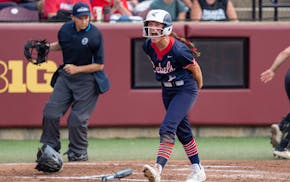With about 80% of Minnesota's deer harvest complete, state wildlife managers are predicting another year of decline in the statewide harvest of whitetails.
Very low deer numbers in northern Minnesota and another drop in the sheer size of the hunt were the primary reasons for the disappointing results. The latest harvest report by the Department of Natural Resources showed a cumulative kill of 130,812 deer so far this fall, a 7.45% decline compared to a year ago.
Archery, muzzleloader and some additional firearms hunting will continue at various times through Dec. 31. Last year's final deer harvest in Minnesota was 172,265, down 7% from the year before.
This year's primary firearms deer season — the biggest hunt of any kind in Minnesota —concluded Sunday with the harvest of more than 106,500 whitetails. Last year, firearms hunters took 112,049 deer during the nine-day season, a year-over-year difference of 5%.
DNR Big Game Program Coordinator Todd Froberg said deer registrations have been extremely low in the northeast, where whitetail populations have been slammed by at least two severe winters in a row. In some areas of the region, severe conditions persisted for three winters. DNR biologists say the resulting loss of mobility for deer and winter food shortages have left the animals more vulnerable to predation. Hunters in the Arrowhead region have complained loudly this year about wolves.
According to the DNR, hunters in the northeast region harvested 18,510 deer over the nine-day firearms season, down 17% from last year and 35% below the five-year mean.
In Minnesota, deer abundance is greatest in the wildlife region that stretches from northwest Wadena County in central Minnesota to the far southeastern corner of Houston County. After a relatively slow start in this year's firearms season, hunters in the region rallied to harvest 37,400 whitetails — about the same as in 2022.
But year-over-year comparisons were unfavorable in Minnesota's two other hunting regions. In the northwest region, hunters harvested 32,820 deer, down 22% from the five-year mean. In the southwest, the nine-day firearms harvest of 17,800 deer was 3.6% below the five-year mean.
Froberg said the lag is especially disappointing given stable and overall "fantastic" weather for this year's firearms hunt. A year ago, the opening weekend of the firearms season was windy and rainy through much of the state. Those conditions were blamed, in part, for a reduction in the statewide firearms harvest from the year before.
Shrinking sales of deer hunting licenses has been a significant factor in the harvest shortfall, Froberg said. It's concerning because hunting is the DNR's primary management tool to control the state's deer population.
According to sales figures released Tuesday, the DNR issued 395,982 deer licenses of all types through Monday, a period that includes the entire primary firearms season. That was down 3% from a year ago. Regular firearms licenses are down 4%, to 310,000.
Wildlife officials have attributed the downturn to a continuing trend of older hunters aging out and not being replaced. This year's deer license sales to youth ages 13 to 17 stand at 35,492, down 5% from last year. At this juncture, Froberg estimates that about 80% of the deer harvest is complete.
Erik Hildebrand, DNR wildlife health supervisor, said the agency's surveillance of chronic wasting disease went well during opening weekend of the firearms season. In special management zones, hunters were required to submit lymph nodes for CWD testing. Of about 9,000 tissue samples taken, about 4,000 results have been returned — a strong pace, he said.
As of Tuesday afternoon, only one returned tissue sample was suspected as CWD-positive. Per routine, more testing is needed to confirm the result.
Hildebrand said the suspect deer was a yearling female, shot in the Climax-Crookston area, about 9 miles from where a CWD-positive buck was shot in 2021. Deer Permit Area 661, where the two deer were taken, is known for having a low harvest because much of it is sugar beet fields that have been harvested by the time firearms season opens. Much of the area's deer habitat is located in the bottoms of the Red River Valley.
Across the river in North Dakota, wildlife officials also are sampling harvested deer for CWD.

Softball state tournament: Champlin Park (4A), Rocori (3A), St. Cloud Cathedral (2A), United South Central (1A) are champs

Champlin Park turns a big moment into the Class 4A softball championship

Rocori rolls past Byron in Class 3A for its first state title in 11 trips

Gophers men's hockey team adds defenseman Finn McLaughlin, who flipped his commitment from Denver

